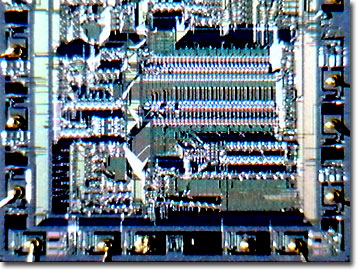Integrated Circuit Image Gallery
Radio Frequency Integrated Circuit
Radio frequency (RF) chip sets have rapidly evolved to 5 GHz clock speeds, based on silicon-germanium (SiGE) bipolar complementary metal oxide semiconductor (BiCMOS) fabrication techniques and other advances by research laboratories such as Lucent Technologies and Raytheon. Playing a starring role in the defense industry's guidance systems, RF chips are more complicated to design than digital chips because they operate at higher frequencies. Despite many wireless communications and network systems termed "digital", the RF chips that support them are analog.

View a medium magnification image of the radio frequency integrated circuit.
View a high magnification image of the radio frequency integrated circuit.
Modeling, testing, and verifying RF circuits is more critical than for digital circuits since higher frequencies increase the level of interference, noise, and distortion. With radio transmission in wireless networks, RF chips allow access to more channels by dividing the limited bandwidth by frequency, time, and code. Multiplexed, these channels are then transmitted at higher throughput rates. Frequency division multiple access (FDMA) technology takes an analog radio transmission and splits the available frequency band into smaller fixed frequency channels. In 1983, commercial advanced mobile telephone service (AMPS) commenced as an analog mobile cellular system based on RF chips that use FDMA to divide the system bandwidth into 30-KHz channels for voice conversations. Each caller's conversation in the wireless network is transmitted at a single frequency range for the duration of the call. Newer, narrowband advanced mobile telephone service (N-AMPS) further divides the 30-KHz units into three 10-KHz channels.
Radio frequency chips that utilize time division multiple access (TDMA), convert analog signals into binary digital signals by chopping the analog signal into segments and encoding each segment. Each encoded segment is then assigned to a different time slot so that for example, a 4-KHz analog voice signal translates to a digital storage oscilloscope signal of 64,000 bits per second. By compressing and then multiplexing encoded signals, TMDA increases the conversation number in a single data stream. Some RF systems combine the time and frequency division multiple access (TDMA/FDMA technology) strategies into a single method for subdividing the available radio bandwidth based on frequency and time, or use code division multiple access (CDMA), based on the RF chipsets. Bluetooth wireless technology eliminates the need for cables within a local area network (LAN). Developed by computing and mobile communications leaders such as Nokia and Toshiba, Bluetooth provides powerful, low-cost connectivity that enables all types of audio-video, computing, and communications devices to "talk" without a physical connection.
Contributing Authors
Omar Alvarado, Thomas J. Fellers and Michael W. Davidson - National High Magnetic Field Laboratory, 1800 East Paul Dirac Dr., The Florida State University, Tallahassee, Florida, 32310.
BACK TO THE INTEGRATED CIRCUIT IMAGE GALLERY
BACK TO THE DIGITAL IMAGE GALLERIES
Questions or comments? Send us an email.
© 1995-2022 by Michael W. Davidson and The Florida State University. All Rights Reserved. No images, graphics, software, scripts, or applets may be reproduced or used in any manner without permission from the copyright holders. Use of this website means you agree to all of the Legal Terms and Conditions set forth by the owners.
This website is maintained by our
Graphics & Web Programming Team
in collaboration with Optical Microscopy at the
National High Magnetic Field Laboratory.
Last Modification Friday, Nov 13, 2015 at 02:19 PM
Access Count Since September 17, 2002: 14586
Visit the website of our partner in introductory microscopy education:
|
|
